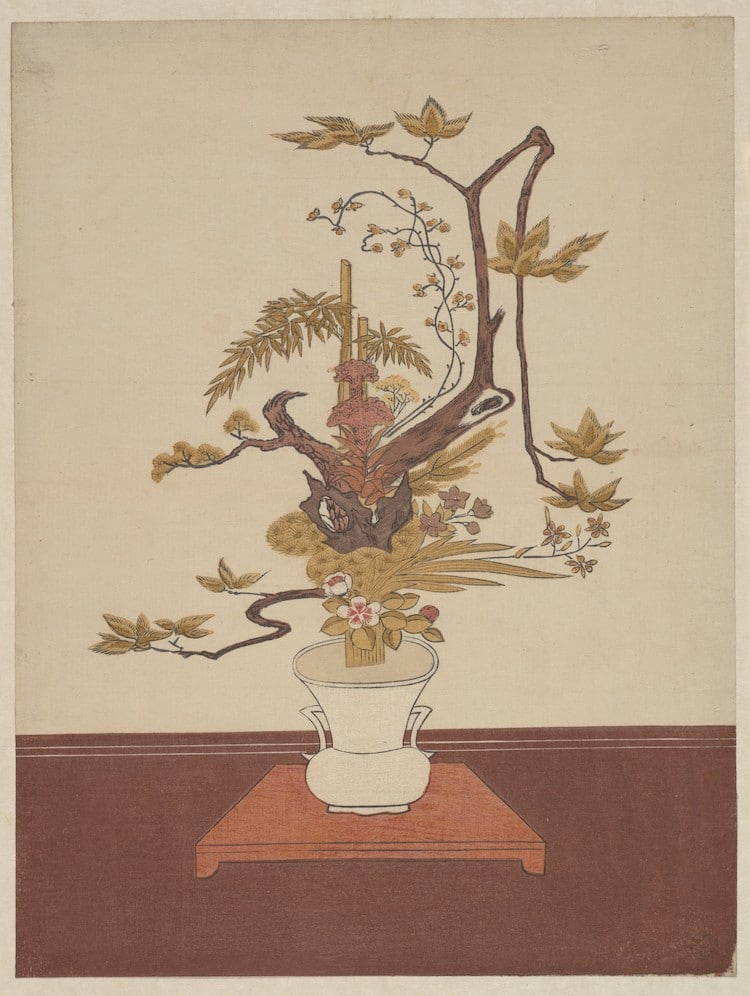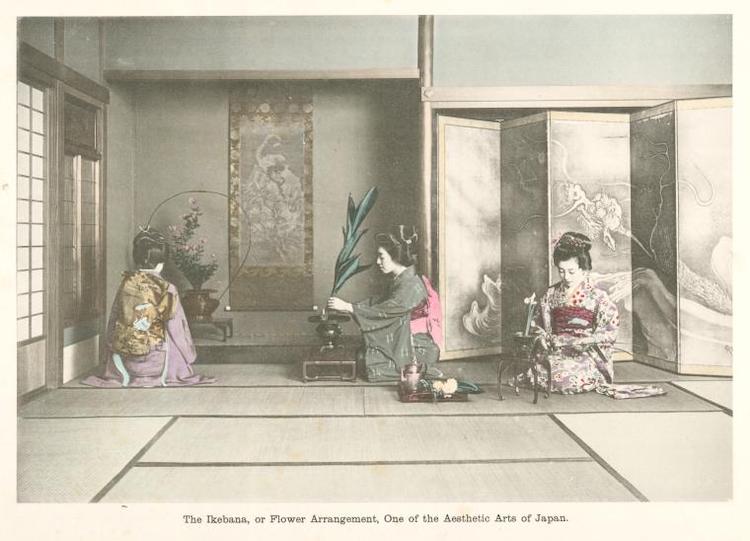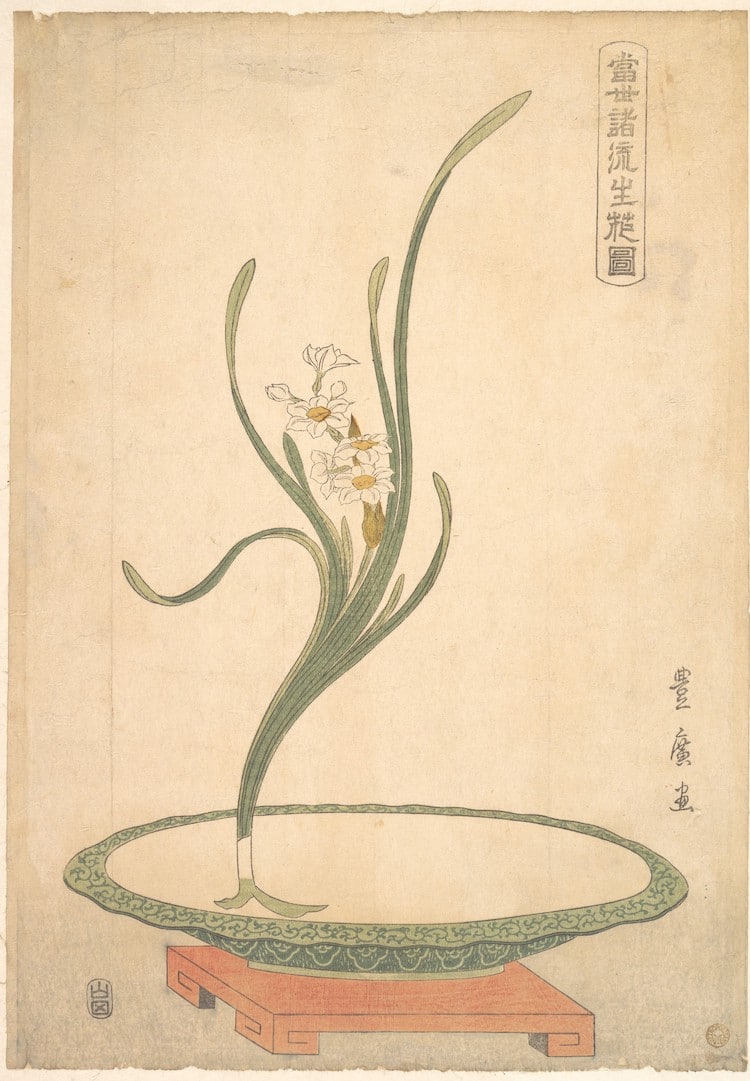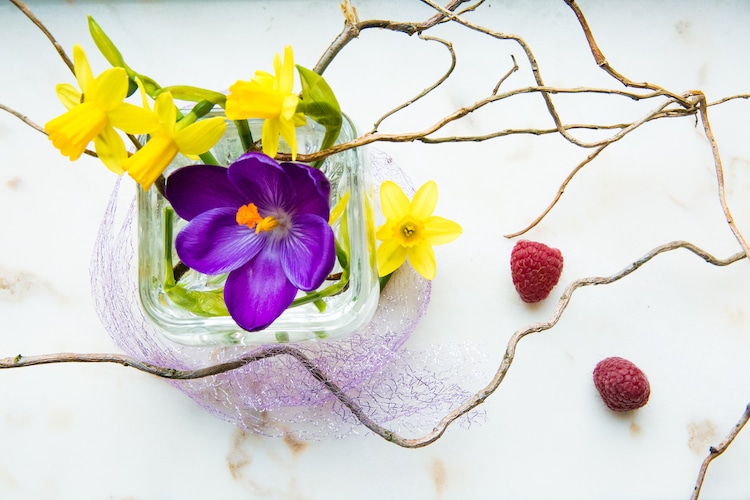
Stock Photos from Majuni/Shutterstock
This post may contain affiliate links. If you make a purchase, My Modern Met may earn an affiliate commission. Please read our disclosure for more info.
Ikebana, or the Japanese tradition of flower arranging, has a long history that dates back to the 7th century. “The Way of Flowers” is a delicate, refined practice where nature becomes the foundation of sculptural art pieces that are known for their simplicity. By using branches, blossoms, and leaves to build up shape and character, ikebana can be used to express emotions.
While ikebana reached its peak in the 16th century, Japanese flower arranging is seeing a comeback, and more and more people are taking up the practice. Today, ikebana is appreciated for the attention to color, form, and lines that allow practitioners to express their creativity. Traditional elements like bamboo grass and plum branches are often mixed with local, seasonal fauna to create new, innovative arrangements.
To understand more about ikebana, also known as kadō, let’s learn a bit about the history and philosophy behind the art form, as well as different styles of Japanese flower arranging.

“Ike Bana (Flower Arrangement) in the Ike-no-bo Style” by Suzuki Harunobu, ca. 1765 (Photo: Public domain via Metropolitan Museum)
The History of Japanese Flowering Arranging
As plants are an inherently important part of the Shinto religion, there is a long tradition of appreciation for seasonal varieties. Many were given special significance and it was common for flowers and plants to be left as a welcome gift for kami—spirits worshipped in Shintoism.
In the 7th century, when Buddhism came to Japan, flowers were regularly left as offerings. The earliest flower arrangements were used as temple offerings, gradually becoming more symmetrical and symbolic. Toward the end of the 15th century, shōgun Ashikaga Yoshimasa became a huge proponent of the tea ceremony and ikebana. He believed that offerings to the gods required special thought and began to codify rules for these flower arrangements.
By the 16th century, different schools of ikebana had been established and it moved out of a strictly religious context. It was often practiced by Japanese generals, who believed that it freed their mind and allowed them to make the proper decisions on the battlefield. At this time, people also had special alcoves in their homes called tokonoma where they would place their flower arrangements.
Though ikebana declined in popularity after the 17th century, there are still more than 1,000 ikebana schools today including Ikenobō. Based at the Rokkaku-dō temple in Kyoto, this largest and oldest ikebana school was founded by a monk in the 15th century.

“The Ikebana, or Flower Arrangement, One of the Aesthetic Arts of Japan.” The New York Public Library Digital Collections. 1910 – 1919. (Photo: Public domain via General Research Division, The New York Public Library.)
Principles of Ikebana
In Japan, flowers and plants are charged with symbolic meaning. Therefore, strict attention is paid to the selection of materials used, which can vary depending on the time of the year.
For instance, Evergreen pine symbolizes eternity—as such, it is often used around the New Year. And on March 3, blossoming peach branches are used in conjunction with the Girls’ Festival. In terms of symbolic meaning regardless of the season, bamboo symbolizes youthful flexibility while blossoming apricot branches demonstrate old age.

“Flower Arrangement of Suisen (Narcissus) in a Flat Green Dish” by Utagawa Toyohiro. Edo period. (Photo: Public domain via Metropolitan Museum)
Symbolism also runs through the shape of the arrangement, as well as the color. Due to the high winds in Japan that occur in March, many arrangements made during this time will have curved branches to mirror the movement of wind. White flowers are used in arrangements meant for a housewarming, as they symbolize water and ward off any possible fire in the home. Conversely, one would want to avoid red flowers in this situation—as they symbolize fire. The language of flowers, known as hanakotoba, helps assign specific meaning to Japanese plants and flowers.
As ikebana became a part of Japanese culture through Buddhism, there are many philosophical aspects that come from the religion. Practitioners of ikebana believe that arrangements should be made with patience and in silence. This meditative aspect allows practitioners to gain a deeper understanding of their materials and appreciation for the overall arrangement, which ultimately brings them closer to nature.

Stock Photos from Majuni/Shutterstock
It’s important to understand that materials can be manipulated in order to highlight their innate beauty. Blossoms can be taken off and reattached in a location that’s more aesthetically pleasing or trimmed to highlight the flowers that remain. Branches can be curved or straightened to create enhanced shapes. Both dried and live matter is used, and are often trimmed or painted as needed.
There are many different schools and styles of ikebana, but a basic principle for many arrangements starts with the idea of a scalene triangle where the main points symbolize the sun, moon, and earth; or, they represent heaven, man, and earth. The selection of a vase is also quite important depending on the school, as the amount of water used and how it’s exposed to the air can affect the overall arrangement.
Styles of Ikebana
As with any art form, ikebana has undergone different stylistic changes throughout the course of history. Many schools subscribe to one of the two major branches that developed early in ikebana’s history.
Rikka
Rikka, which translates to “standing flowers,” is a style that developed in the 15th century during the Muromachi period. It’s said that rikka is really what established ikebana as we now know it.

Example of rikka arrangement from “Rikka-zu narabini Sunamono,” 1673. (Photo: Wikicommons)
This formal style follows rigid rules and often makes use of wiring in order to construct harmonious, scenic landscapes. Arrangements consist of nine main lines called yakueda that are intended to reflect the character of the plants. The height and position of each line is critical to arrangements, which are typically done in a tall vase measuring 20 to 30 centimeters tall (7 to 11 inches high) using a kenzan to hold the stems in place.
Arrangements in the modern rikka shimputai style, which was created in 1999, allow for more creative expression and break from the rigidity of the more formal rikka shofutai. Instead of nine main lines, shimputai arrangements rely on two contrasting parts used in a single vase. This can be a contrast of color, texture, or material. These modern arrangements are known for their bright, striking appearance.
Nageire
Different views of an arrangement focusing on contrast and lines Material: Agapanthus, willow, leave, ceramic container #nageire #sogetsu #ikebanard pic.twitter.com/lSObaoNA55
— Ikebanard (@ikebanard) July 3, 2018
Also known as heika or nageirebana, this style has its foundation in the secular world. While an emphasis is still placed on the character and meaning of the plants and flowers, nageire is less rigid than the more formal rikka style.
This free flowing nature is exemplified by the legend behind its creation. It’s said that a samurai threw flowers into an open vase, the resulting arrangement gave birth to nageire, which means “thrown in.”
The triangular composition and color harmony found in rikka are only loosely followed in nageire and a kenzan is not typically used to hold stems in place. Leaning compositions are typical of nageire, and this is subdivided into three categories—Upright (Chokutai), Slanting (Shatai), and Cascading (Suitai).
Next: Ikebana today and where to purchase supplies—including vases—to start your next arrangement.
